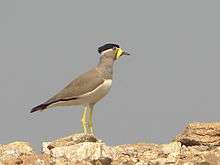lapwing
English
Etymology
From Old English hlēapewince, from hlēapan (“to leap”) + *winc- ("sway, totter") (because of its manner of flight). The modern form is influenced by folk etymology.
Pronunciation
- IPA(key): /ˈlæpwɪŋ/
Noun
lapwing (plural lapwings)
- Any of several medium-sized wading birds belonging to the subfamily Vanellinae within family Charadriidae.
- 1986, Steven L. Hilty, Bill Brown, A Guide to the Birds of Colombia, page 149,
- Plovers and lapwings are a large, virtually worldwide family that differs from sandpipers in, among other things, having a shorter, thicker, pigeonlike bill and more robust proportions.
- 2010, Des Thompson, Ingvar Byrkjedal, Tundra Plovers, page 36,
- The resident tropical plovers have much less pointed wings, and most of the lapwings have fairly rounded wing-tips, a wing shape apparently more adapted to aerial manoeuvrability than to long-distance migration.
- 2010, Clive Finlayson, Birds of the Strait of Gibraltar, page 244,
- Lapwings are abundant winter visitors to the area but, like the Golden Plovers, vary greatly in number between years.
- 1986, Steven L. Hilty, Bill Brown, A Guide to the Birds of Colombia, page 149,
- The tewit (Vanellus cristatus) (which is a type of lapwing in the first sense).
- A silly man.
- 1602, William Shakespeare, Hamlet, Act V Scene 2,
- This lapwing runs away with the shell on his head.
- 1602, William Shakespeare, Hamlet, Act V Scene 2,
Derived terms
Translations
bird belonging to the subfamily Vanellinae
|
|
See also
This article is issued from
Wiktionary.
The text is licensed under Creative
Commons - Attribution - Sharealike.
Additional terms may apply for the media files.
